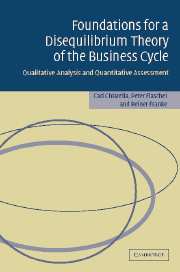 Foundations for a Disequilibrium Theory of the Business Cycle
Foundations for a Disequilibrium Theory of the Business Cycle 1 - Competing approaches to Keynesian macrodynamics
Published online by Cambridge University Press: 22 September 2009
Summary
Introduction
General methodological remarks
This book proposes a view of dynamic macroeconomic modelling that stresses the non-market-clearing approach. Here the focus is very much on dynamic adjustment processes amongst the principal markets and agents of the macroeconomy and the dynamic linkages between these. Our starting point is the Keynes–Metzler–Goodwin (KMG) model developed in earlier work of the authors together with other collaborators. The label is meant to highlight the key macroeconomic mechanisms introduced by the great economists referred to. The ‘Keynes’ refers to the causal nexus from financial to real markets, ‘Metzler’ to inventory dynamics and ‘Goodwin’ to the dynamics of distributive shares. It is our view that these are the core mechanisms which need to be at the heart of descriptive models of the macroeconomy.
An important aim of our analysis is to understand the dynamic interplay between these core driving mechanisms of the macroeconomy, in particular which are stabilizing and which destabilizing, and which parameters have the most influence in moving the economy back and forth between the regions of stability and instability. In the shock-driven models of modern macrodynamics a stabilizing effect is one that reduces the variance of some important state variables; however, here we are almost exclusively concerned with deterministic systems, and so the terms ‘stability’ and ‘instability’ are used in the sense that they refer to the local properties of the steady state.
- Type
- Chapter
- Information
- Foundations for a Disequilibrium Theory of the Business CycleQualitative Analysis and Quantitative Assessment, pp. 1 - 60Publisher: Cambridge University PressPrint publication year: 2005
